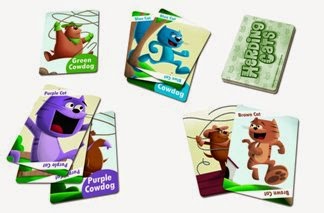When I began working in the public schools, I quickly
realized that there was a great need for social skills groups. Parents and staff seemed to be under the impression that this was an area of expertise for SLPs -- which most of you would agree is definitely NOT an accurate assumption! The only instruction on social skills that I have received in my graduate program is to be taught the definition of the term "pragmatics." That's pretty much where it ended. However, I was expected to work on this with a large number of students.
Not sure where
to begin, I purchased tons of books on the subject. Unfortunately, most programs out there didn’t meet my needs – the lessons and activities
were either too challenging / not engaging / too easy / required materials that
you had to make yourself / etc. And - don't hate me - but even Michelle Garcia Winner's materials were a bit too dry for my students.
Over the last three years I have taught
elementary level social skills groups by piece-mealing my own curriculum and developing my own lessons and
activities. This summer, I decided to relinquish my break and finally sat down to type up actual lesson plans, including some of the activities that I have done with my groups and adding many, many more
ready-to-use materials and activities. While this project pretty much consumed my summer break, I felt it was something that I really had to do. The finished result is a resource that
is (hopefully!) easy to implement and can be used with different elementary
populations to work on social skills.
 |
| Click on the picture to see the product in my TPT store! |
The completed bundle contains 37 lesson plans and 229 supplementary
activities for Elementary to Middle school level social skills groups. Each lesson is designed
to last between 30 – 60 minutes (although you can stretch each lesson across
several sessions by doing multiple of the included activities). Of course it is ready for sale in my TPT store (I have also made the individual sections available).
Each lesson contains a variety of activities to choose from
so that you can pick the one that most suits the group you are teaching and/or
your teaching style. While some of these activities focus on relevant
children’s books and require that you own the book, most of the activities are
original creations by myself.
Each lesson is set up as follows: Students are being taught
the skill during a whole group discussion. The second part of each lesson is
comprised of activities. Each lesson contains 3-13 suggestions for relevant
activities, and this section will hopefully grow over time as I discover more
things to do with my groups. The topics covered in my curriculum are as follows (each individual section is also available for sale if you do not want to purchase the entire program):
 |
| Some sample activity pages. |
I.FRIENDSHIP BASICS
Lesson #01: Introduction to Social Skills Group (+3 Activities)
Lesson #02: Behavior Expectations and Rules (+6 Activities)
Lesson #03: Introducing Yourself (+3 Activities)
Lesson #04: Getting to Know Each Other (+6 Activities)
Lesson #05: What Is a Friend? (+4 Activities)
Lesson #06: Filling Buckets (+3 Activities)
Lesson #07: Giving and Receiving Compliments (+3 Activities
II.CONVERSATION SKILLS
Lesson #08: Whole Body Listening (+6 Activities)
Lesson #09: STEPS (an acronym developed by myself) (+3 Activities)
Lesson #10: S = Space (+5 Activities)
Lesson #11: T = Take Turns (+6 Activities)
Lesson #12: E = Eye Contact (+6 Activities)
Lesson #13: P = Polite (+3 Activities)
Lesson #14: S = Stay on Topic (+6 Activities)
Lesson #15: Volume (+5 Activities)
III.FEELINGS & ANGER MANAGEMENT
Lesson #16: Basic Emotions (+8 Activities)
Lesson #17: Complex Emotions (+9 Activities)
Lesson #18: Body Language & Prosody (+5 Activities)
Lesson #19: Dealing With Anger (+10 Activities)
Lesson #20: Relaxation Techniques (+8 Activities)
Lesson #21: Sensory Techniques (+13 Activities)
Lesson #22: Dealing With Change (+7 Activities)
Lesson #23: Self-Control (+5 Activities)
IV. BEING PART OF A GROUP
Lesson #24: Joining a Group (+5 Activities)
Lesson #25: Playing a Game (+7 Activities)
Lesson #26: Dealing With Losing (+6 Activities)
Lesson #27: Sharing (+8 Activities)
Lesson #28: Fairness & Compromising (+9 Activities)
V. PROBLEM-SOLVING & MANAGING CONFLICTS
Lesson #29: Identifying Problem Sizes (+4 Activities)
Lesson #30: Solving Problems (+8 Activities)
Lesson #31: Group Problem-Solving (+5 Activities)
Lesson #32: Bullying (+9 Activities)
Lesson #33: Dealing With Teasing (+7 Activities)
Lesson #34: Tattling (+4 Activities)
Lesson #35: Resolving Conflicts (+9 Activities)
VI. SOCIAL THINKING
Lesson #36: Perspective-Taking (+10 Activities)
Lesson #37: Thinking & Talking Bubbles (+5 Activities)
I am planning to add more lessons on SOCIAL THINKING within the next months and have drafted outlines for the following topics:
Lesson #38: Social Filter
Lesson #39: Flexible Thinking
Lesson #40: Empathy
These lessons offer a great pre-cursor to higher-level social skills programs and are designed to be a comprehensive first exposure to a social skills group. While I organized these lessons by category, you can of course use them in any order you see fit, and they can be stand-alone lessons. You can do these lessons in a social skills group setting, in a whole classroom setting, or during a speech therapy / counseling session as needed.
I have started using this curriculum with my groups last week and will post a lot of updates this year about how it is working out for us! I think this is the first year where I don't have to go into the social skills group with just a vague idea of what we're doing that day, and that feels great!
~Viola
















